This was published 7 months ago
Homes v habitat: The fight to save a forest amid a population boom
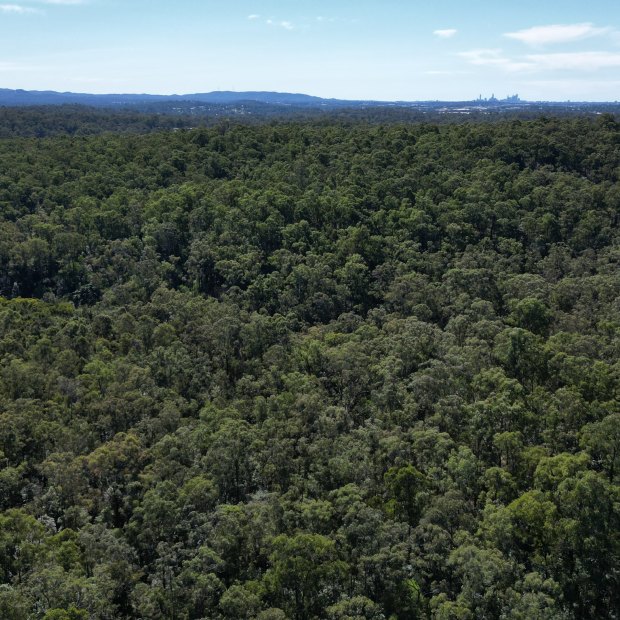
Aerial shot of Woogaroo Forest in Springfield. Brisbane CBD’s skyline is visibile on the horizon. Under the proposed development, a significant portion of the forest will be cleared. Credit: Save Woogaroo Forest
Crouching in the crest of a gully, Anna* retrieves a map from her backpack and finds her place in Woogaroo forest.
The area, situated between Brookwater, Bellbird Park, Camira and Springfield in Ipswich, spans about 420 hectares of natural woodland and rainforest.
Brisbane’s CBD – distant as it feels under the canopy of eucalyptus trees – is only a 35-minute drive away, a proximity that can’t be underestimated.
An extra 2.2 million people are expected to call south-east Queensland home by 2046, bringing the population to roughly 6 million. The government estimates 900,000 new homes will be needed to support the region’s growth – the rate of which is already far outstripping supply.
The forest is a rare sanctuary against the spread of urban sprawl edging from the inner city. For now, at least.
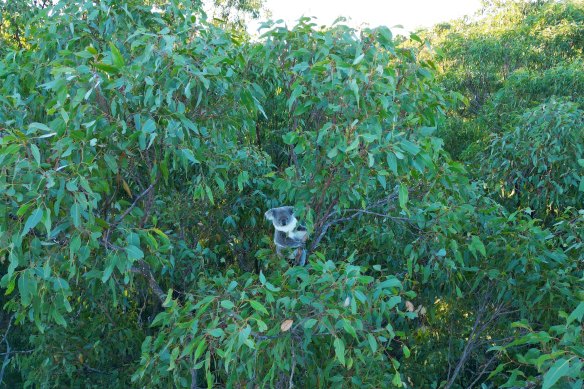
“Tanya”, one of the forest’s resident koalas, has become familiar to campaigners. Credit: Save Woogaroo Forest
“Sometimes I come here just to sit down because you have these rises on all sides, so it blocks out the noise,” Anna says. She nods to the top of the gully: “They want to cut 14 metres off the ridges and fill all the gullies in, flatten it out.”
“They” are Stockland, one of Australia’s largest residential developers and the group behind plans to clear-fell 120 hectares of forest. Anna is a founding member of Save Woogaroo Forest, a group of residents fighting to protect the patch from development.
The emblem of their fight is south-east Queensland’s dwindling population of endangered koalas which, along with more than 130 native species, call the forest home.
“The dots are koala sightings,” she says, pointing to a map, “there have been a lot more since [it was made]”.
“We’ve already been told that if the development goes ahead, that will be it. They will not survive.”
The group’s environmental concerns have been reinforced by a sweep of experts; ecologists, academics and wildlife organisations. But under current planning legislation, they’re overridden by rules created more than 30 years ago.
Woogaroo forest has been earmarked for development for decades.
It’s part of 7000 acres of forested land between Ipswich and Brisbane purchased by Maha Sinnathamby and business partner Bob Sharpless in 1992. At the time, only 10 per cent was zoned for residential development. Three decades on, it’s Australia’s newest emerging city and the fastest-growing region in south-east Queensland. It’s current population of about 50,000 is expected to swell to 105,000 by 2030.
Its growth has been enabled by a unique planning instrument called the Springfield Structure Plan (SSP). This is one of three Development Control Plans operating in Queensland. DCPs allow larger-scale developments to bypass many state regulations, including vegetation clearing and protections for koala habitat.
The first development, Springview Estate, Village 1 (renamed “Kalina”) was referred to the Environmental Protection and Biodiversity Conservation Act (1999) for assessment due to risks posed to threatened species such as koalas. This level of federal intervention can trump the SSP.
The report submitted by Saunders Havill Group found no koalas during pre-clearance surveys, concluding they “occur on-site infrequently”. Village 1 was approved in 2017 and is now complete.
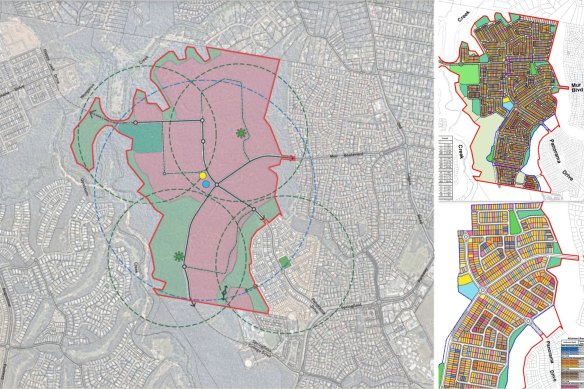
Development plans for Villages 2 and 3.Credit: Ipswich City Council/Stockland
Stockland’s plans for Villages 2 and 3 would add another 1800 houses, a commercial centre, a childcare centre, and a local sports park. The Precinct Plan for both was approved by Ipswich City Council on March 21, 2024, days after the council election, and are now under EPBC assessment.
A spokesperson for the Department of Climate Change, Energy, the Environment and Water said the development would not be approved “unless they [the minister] are satisfied that impacts to our threatened plants and animals are suitably avoided or managed”.
“Once the department has received satisfactory assessment documentation for Springview Estate Villages 2 and 3, the proponent will be directed to publish it and seek public comments,” they said.
“The tension between needed, affordable housing and the protection of our native landscapes and wildlife is one council endeavours to manage responsibly and transparently.”
Ipswich City Council chief executive Sonia Cooper, March 2024
More than 200 public submissions were lodged to Ipswich council in response to Villages 2 and 3. Despite SSP exemptions, campaigners are hopeful they can stop the next stage of development from going ahead. So far, their petition urging federal Environment Minister Tanya Plibersek to intervene has gained more than 12,000 signatures.
The group need visibility, but have requested anonymity out of fear for their safety. Some years ago, Ipswich Residents and Ratepayers’ Association president Jim Dodrill was bashed in nearby bushland after documenting concerns about trail bikes in the area. There have been other reports of threatening behaviour in the years since; these can be emotive issues.
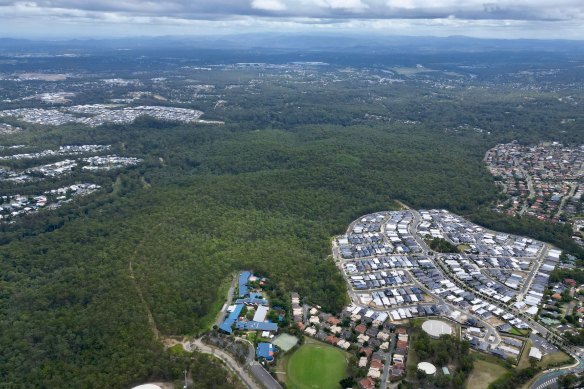
Woogaroo forest and bordering estates. Assessments carried out before the first stage of the development found insufficient evidence of koalas. Campaigners say this contradicts their knowledge of the forest.Credit: Save Woogaroo Forest
“I think the big issue is that the Springfield Development Plan was basically written last century,” says Renee*, one of the group’s co-ordinators and a resident of Bellbird Park for 20 years.
Like many locals, she is frustrated by the legislation’s lack of continuity with protections for koalas, which have become endangered since the SSP was enacted in the late ’90s. Other vulnerable species, such as the powerful owl and platypus, are also at risk.
“If we’re serious about trying to prevent koalas from becoming extinct in south-east Queensland, you can’t have a situation where state government law is superseded by something that was written 30 years ago,” Renee says.
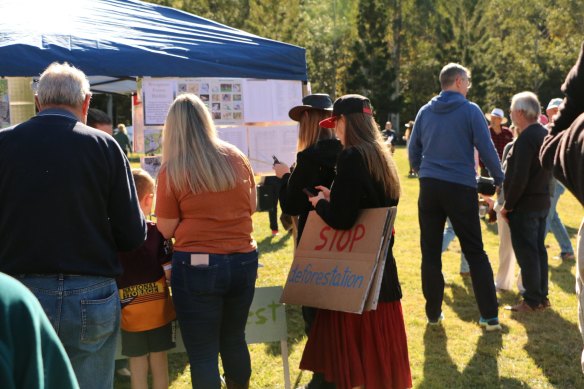
Locals gather at a rally organised by Save Woogaroo Forest in June. Credit: Save Woogaroo Forest
Koalas were listed as endangered in Queensland, NSW and the ACT in 2022. That year, a 10-year national recovery plan made under the EPBC was enacted to stop their decline and improve their habitat. South-east Queensland also has a Koala Conservation Strategy.
In response to the submissions, Stockland has promised to retain native wildlife corridors and koala habitat trees, and more open space than required through the SSP.
“But open space doesn’t automatically mean the preservation of sensitive ecosystems,” Renee says.
Who needs the land more?
Advocates say the forest is home to hundreds of native species – birds, insects, mammals and plants. It’s core koala habitat, and despite assessors finding limited evidence of the elusive marsupial, the group is certain a population lives here.
If they have their way, Woogaroo will be preserved not just for the plants and animals, but for future generations to enjoy, similar to Toohey Forest.
South-east Queensland’s human population is under similar stress. It’s one of the fastest-growing pockets with a severe shortage of housing. Springview Estate would help accommodate thousands of people.
How affordable that housing would be is difficult to predict.
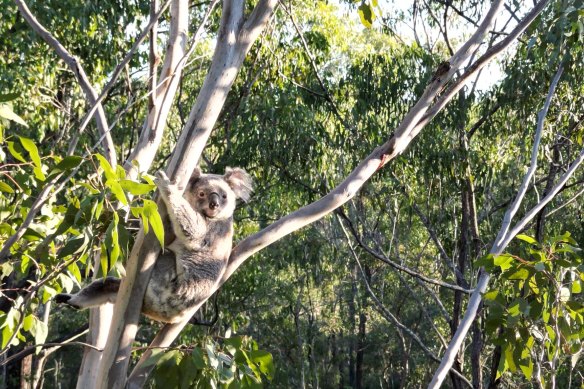
A koala spotted in Woogaroo forest by one of the campaigners. Assessment of the forest before the Kalina estate was built found little evidence of koalas living there. Credit: Save Woogaroo Forest
The current median price for a three-bedroom house in Springfield is $634,000, and $800,000 for a four-bedder. The plan for Villages 2 and 3 is for one- and two-storey detached homes on lots that average about 400 square metres.
Asked whether campaigners would feel differently if the plans included more medium-and high-density housing, Anna is unconvinced. “We don’t want to lose any of it. Once the forest is gone, it’s gone.”
Start the day with a summary of the most important and interesting stories, analysis and insights. Sign up for our Morning Edition newsletter.